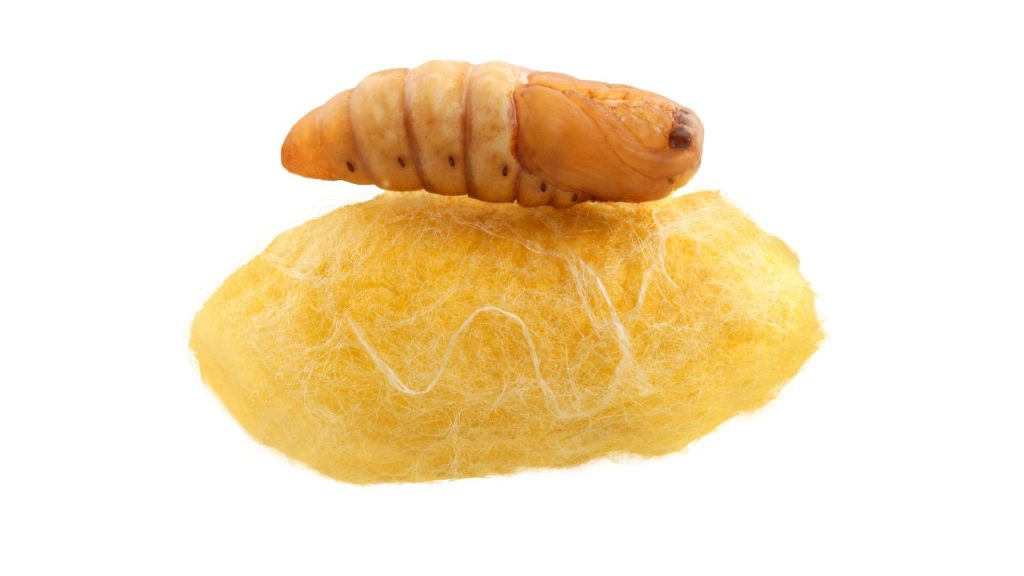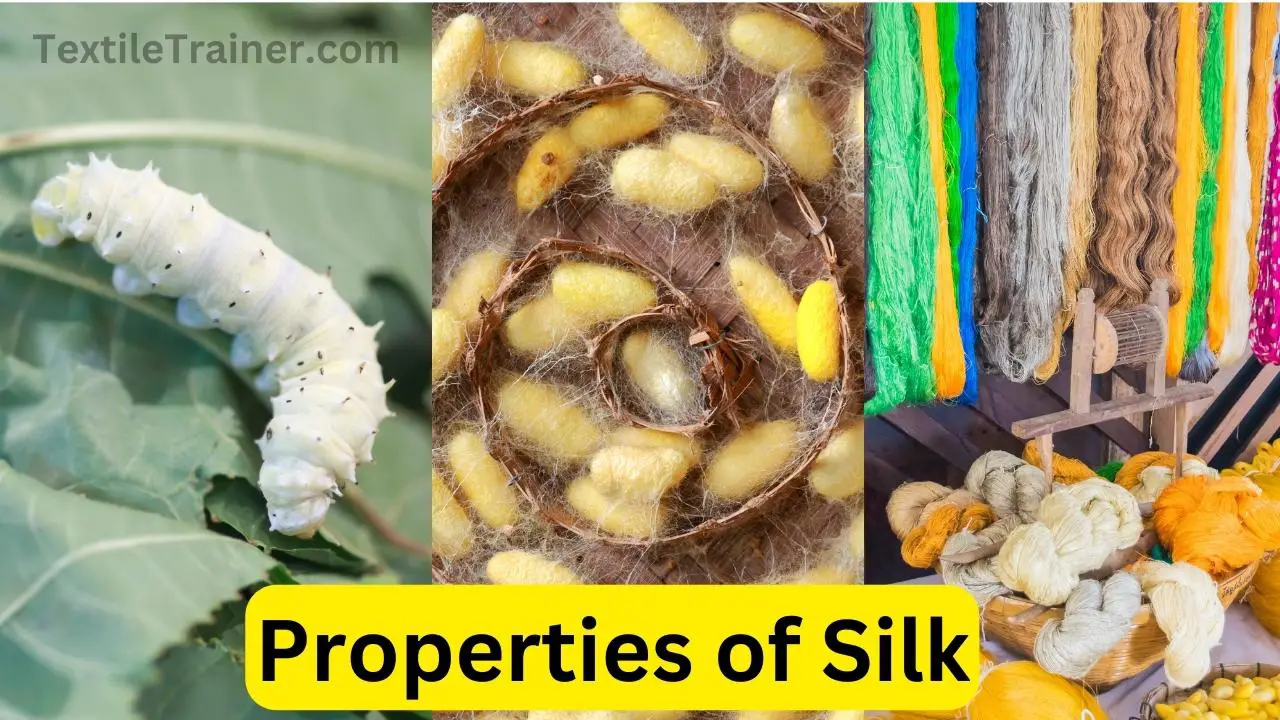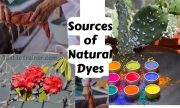Introduction:
Physical and chemical properties of silk fiber is described simply. The most economically viable silk comes from mulberry silkworms, which can be raised in captivity and produce silk in mass quantities. Various insects can produce silk, including caterpillars, spiders, and worms. To produce a silk cocoon, the larva must feed on mulberry leaves for up to one month after birth. Workers kill the larva inside the cocoon using hot water or steam after creating the cocoon, and then they proceed with the rest of the manufacturing process. However, at first we will describe physical properties of silk and then chemical properties of silk.

Physical properties of silk:
Molecular chains and fiber orientation determine silk’s physical, chemical, and clothing comfort properties. Similar to leaf layers in a book, these chains are oriented in crystalline layers, resulting in excellent strength and resilience. Silk aim, or sericin, is a transparent, water-soluble protein, usually white to yellow or orange-yellow for mulberry silk or light brown to reddish-brown or dark brown for Brazilian silk.
1. Tenacity and Extensibility:
Silk fabric has a high tenacity because of its linear, beta-configuration polymers and highly crystallized polymer system, which permits many more hydrogen bonds to form more regularly. Silk is stronger than cotton or linen. Wet silk loses up to 20% of its strength. This is due to water molecules hydrolyzing a significant number of hydrogen bonds, weakening silk polymers. Extensibility is good; it ranges between 10% and 30%.
2. Elastic-plastic nature:
The silk fabric has excellent resilience. Except for very fine, smooth, weighted woven fabrics, it does not wrinkle badly and tend to fall out of shape. Because silk is made of very crystalline polymers, it does not allow the same degree of polymer movement as an amorphous polymer system, so it is more plastic than elastic. As a result, if the silk fabric is stretched excessively, the silk polymers, already stretched (they have a beta-configuration), will slide past each other. The process of stretching ruptures a significant number of hydrogen bonds. The polymers do not return to their original positions when stretching stops but remain in their new positions. As a result, silk’s polymer system becomes disorganized, leading to the textile’s distortion, wrinkling, or creaking. A silk handle is described as a medium, and the very crystalline polymer system imparts a certain amount of stiffness to the filaments due to its very crystalline polymer system. This is misinterpreted because the silk filaments have a smooth, even, regular surface, making the handle appear soft.
3. Hygroscopic nature:
Silk has a very crystalline polymer system, so it is less absorbent than wool due to its greater crystallinity. Silk allows fewer water molecules to pass through its polymer system than wool does with its amorphous polymer system. Silk also has hygroscopic properties similar to wool’s and is more moisture-absorbing than cotton. Silk, like wool, can absorb and hold about 1/3 of its weight in water vapour without feeling wet. In fiber interiors, liquids are quickly absorbed into non-crystalline regions. They dry rapidly, and perspiration deteriorates and discolours dyes.
4. Thermal properties:
In contrast to wool, silk is more sensitive to heat due to the absence of covalent cross-links in the polymer system, whereas wool has disulphide bonds in its polymer system. Once the temperature rises above 100 °C, the silk polymer system’s existing peptide bonds, salt links, and hydrogen bonds break down. Silk is both warm and cool at the same time. During the manufacturing of filament silk, a small amount of air is enclosed in fine fabrics, which lay smoothly on the skin, giving a cooling effect. The layer of warm air between fabric and skin cannot escape easily, so the silk fabrics are good insulators.
5. Electric properties:
Because of its poor conductivity of electricity, it builds up a static charge from friction. It contains moisture, which conducts the charge away.
6. Fiber Blending:
Generally, silk is processed as pure fiber. It can be blended with practically all apparel fibers primarily as it can be used in blends with staple fibers. Blends with wool and fine (high-quality) animal hair are highly valued.
Other Physical Properties of silk at a Glance:
| Properties | Description |
| Density | 1.21 to 1.34 gm/cm3 |
| Diameter | between 10 µm and 8 µm. |
| Length to width ration | 2000:1 |
| Linear density | 1.17 Dtex |
| Color | There are a variety of colours, including white, yellow, yellowish green, and golden yellow. |
| Skin comfort | In addition to the fineness and softness of silk, it is very pleasant to wear because it is very comfortable. |
| Luster, fineness and handle | Among the most essential characteristics of degummed silk are its lustre, fineness, and pleasant handling. |
Chemical Properties of Silk
1. Effect of acids:
There are no covalent cross-links between silk polymers, unlike wool polymers with disulphide bonds, so acids more easily degrade silk. Thus acidic perspiration will immediately cause a breakdown of the silk polymer system, which is generally noticeable as a distinct weakening of the silk textile material.
2. Effect of alkalis:
The silk filament swells when exposed to alkaline solutions. This occurs because the silk polymers are partially separated from the alkali molecules. Hydrogen bonds, Salt links, and van der Waals forces hold a silk polymer system together. Since the alkali hydrolyses these interpolymer forces of attraction, the silk filament dissolves readily in the alkaline solution. Initially, silk dissolution means only the separation of polymers from each other. However, prolonged exposure would result in peptide bond hydrolysis, which would lead to polymer degradation.
3. Effect of other solvents:
Chlorine bleach may damage silk fiber.
4. Effect of sunlight and weather –
Silk fiber is less resistant to the environment than wool due to its polymer system’s lack of covalent cross-links. Sunlight can turn white silk yellow and weaken the fiber.
5. Effect of perspiration:
Sweat, deodorants, and perfumes can cause fiber color changes and embittering. Arm linings should be worn to prevent these changes.
You May Read:







2 thoughts on “6 Physical and Chemical Special Properties of Silk: Ensure High Quality”